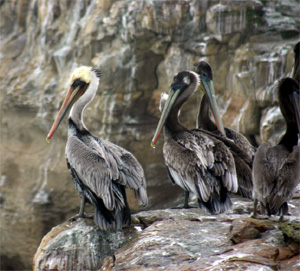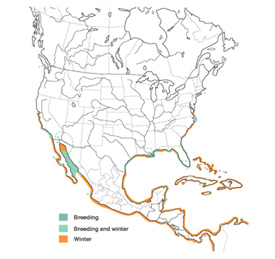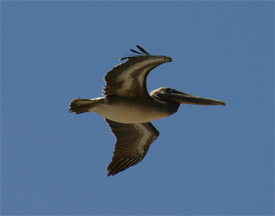
While it may seem that much of the recent ocean news is gloomy, this is a success story! After spending almost three decades on the endangered species list, the Brown Pelican (Pelecanus occidentalis) has made a successful recovery and was removed from the list by the Fish and Wildlife Service on December 17, 2009.
The status of the Brown Pelican throughout the last century has tracked the development of some important U.S. environmental policies. The first National Wildlife Refuge was located at Pelican Island and created in 1903 by Theodore Roosevelt in response to a pelican population decimated by hunting. At the time, pelican feathers had been in demand for use in hats. Sixty years later, Brown Pelicans were facing more difficult challenges.
In the 1960s and 1970s, populations of Brown Pelicans, Bald Eagles and other birds rapidly declined as a result of bioaccumulation of DDT, a pesticide and persistent organic pollutant (POP). DDT accumulated in the fatty tissues of Brown Pelicans through the consumption of contaminated fish, ultimately causing their eggshells to thin and break during incubation. In 1962, Rachel Carson brought the damaging effects of DDT to the attention of a wide public audience with the publication of Silent Spring, and a ban was placed on the chemical in the U.S. in 1972. The Brown Pelican was first declared endangered in 1970, which was reinforced by the Endangered Species Act of 1973.

What we commonly call the Brown Pelican is actually comprised of five subspecies. The subtle differences between subspecies include features such as the color of their plumage and soft parts (e.g., legs, feet, bill). Local populations of the Brown Pelican are difficult to define because their breeding patterns and wintering areas often shift due to local conditions. However, populations of Brown Pelicans in Alabama, Georgia, Florida and the Atlantic Coast were differentiated from remaining U.S. populations and removed from the endangered species list in 1985.
Brown Pelicans occur exclusively in marine areas and are not found more than 20 miles out to sea nor on freshwater inland. They prefer to breed on small coastal islands free from mammalian predators. The main breeding areas in California are in the Southern California Bight on Anacapa and Santa Barbara Islands. In the 1960s and 70s this population was reduced to only 1,000 breeding pairs of pelicans, but in 2006 a census documented 11,695 breeding pairs in 10 locations in the region. The latest estimate of the global population of Brown Pelicans is 650,000 individuals throughout the Atlantic and Pacific coasts of North and South America and the Gulf of Mexico.
Brown Pelicans can often be seen in the Monterey Bay National Marine Sanctuary riding the upcurrent winds from waves as they break, or plunge-feeding for fish that school in nearshore waters. The Brown Pelican is the only one of eight pelican species that utilizes plunge-feeding to hunt fish. They can spy their prey from 60-70 feet up in the air.

Their extended pouch holds up to three gallons of water, which they must first strain off before consuming their fish feast; their stomachs hold only one gallon. Brown pelicans eat approximately four pounds of fish per day and weigh between eight and ten pounds.
The Brown Pelican provides an encouraging example of how environmental policy, in conjunction with efforts of federal, state, local and conservation agencies, has led to the successful recovery and subsequent delisting of an endangered species. The Brown Pelican will remain protected under the Migratory Bird Treaty Act and its status will continue to be monitored to ensure the continued health of the species.
|